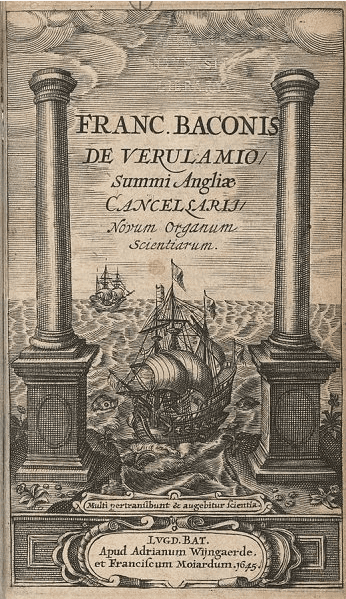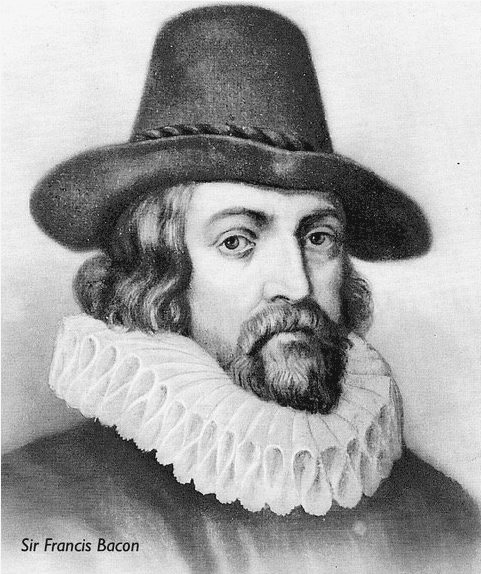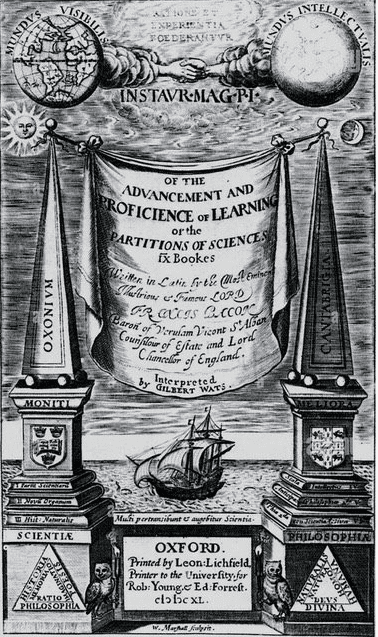JMS Pearce
Hull, England
 |
| Fig 1. Novum Organum Scientiarum, 2nd edition, 1645. EC.B1328.620ib, Houghton Library, Harvard University. Via Wikimedia. Public domain. |
Lord Bacon was the greatest genius that England, or perhaps any country, ever produced.
– Alexander Pope, 1741
The early seventeenth century was a time when natural philosophy, the precursor of modern science, was advanced dramatically by names still famous 300 years later. Philosophy and natural philosophy were intimately bound concepts, both inchoate, both awaiting bold ideas, definition, and development.
Celebrated amongst many pioneers was William Harvey and his Exercitatio anatomica de motu cordis et sanguinis in animalibus (1628) in which he established the anatomy of the circulation of the blood. Twenty-three years before Harvey’s discovery, Francis Bacon published The Advancement of Learning and in 1620 his Novum Organum Scientiarum (Fig 1), in which he tried to put natural sciences on an empirical base and establish an original scientific method. Its essence has stood the test of time.
Francis Bacon
Francis Bacon, Viscount St. Alban (1561–1626), was a statesman and philosopher who became the father of modern scientific methods. He was considered to be a major founder of the English Renaissance. Not only was he named “The Third Plato,” but the Royal Society acknowledged him as their instaurator. In one of many eulogies* he was portrayed as “The very nerve of genius, the marrow of persuasion, the golden stream of eloquence, the precious gem of concealed literature, the noble Bacon has fallen by the fates.” (R. C. Elegy 9, Manes Verulamiani, 1626)
 |
| Fig 2. Sir Francis Bacon. |
He read law at Trinity College Cambridge and at Gray’s Inn. He held office in Parliament for more than thirty years from 1584 to 1617 during which time he was venerated in politics, law, and in the royal court. Under Queen Elizabeth I, he was appointed Extraordinary Counsel. Under King James I, son of Mary Queen of Scots, Bacon was knighted and appointed King’s Counsel, then successively Solicitor General, Attorney General, Privy Councilor, Baron Verulam, Viscount St. Alban, and Lord Chancellor. But misfortune was to follow. It was a period of political and religious turmoil as a Protestant reformation swept the country, often with violent effects.
In 1621 the House of Commons questioned the legality of the monopolies created by the extravagant King James, and to deflect regal blame, a foul plot initiated by the fastuous Sir Edward Coke accused Bacon of receiving bribes. He denied the charge, but the King commanded him to plead guilty. He was fined and put in gaol.1 Since the King could do no wrong, Bacon reluctantly ceded: “I am ready to make an oblation of myself to the King in whose hands I am as clay to be made a vessel of honour or dishonour.” The fine was later remitted, his freedom was restored, Parliament reversed his sentence, and his annuity of £1,200 was restored.
After this affray with the law in 1621, he relinquished public duties. But undeterred, the philomath Bacon continued his efforts to illuminate natural science and delineate the principles of scientific methodology.
The principles of new science
 |
| Fig 3. Of the Advancement and Proficience of Learning, 1605. University of Sydney rare books collection. Via Wikimedia. Public domain. |
Bacon’s first step was to criticize past educational and philosophical systems that he believed had stagnated. As early as 1605, in The Advancement of Learning (Fig 3) he provided more accurate explanations of natural phenomena—the scientific method. In particular he derided the prevailing philosophies of Aristotelian scholasticism, aesthetic humanism, and occultism.2
He insisted that empirical observations and data led to inductive reasoning—a recurring theme. Observations must precede attempts at rational explanation. By this approach he sought to counter the evident frailties of the human mind, which he observed were beset by bias and misperceptions that concealed reliable data, reasonable hypotheses, and the truth. Logic rather than rhetoric was fundamental to Bacon’s thinking.
His later Novum Organum Scientiarum (1620) contained precise instructions for “removing Idols,” those fallacies that, which might distort or conceal a scientific truth, while he indicated the best method was tabulating facts and data. His tables of observations yielded conclusions based on what he called induction. This construction and testing of a hypothesis was to be the underpinning of all scientific study, although his ideas were not fully appreciated until the nineteenth century. Klein and Giglioni give a detailed exposition and analysis.2
Four Idols
He classified the false or misleading ideas in the human mind as Four Idols:
- The Idols of the Tribe: intellectual oversimplification;
- The Idols of the Cave: the intellectual peculiarities of individuals;
- The Idols of the Marketplace: the unreliable nature of language; and
- The Idols of the Theatre: all beliefs in any degree of generality.
To counter these flawed notions, his philosophical Novum Organum aimed to correct and replace them. This process of guiding proper observation and data collection he called induction.
Bacon’s method, as explained in Novum Organum, contained three steps:
- Description of facts
- Cataloguing those facts into three categories: instances of the presence of the characteristic under investigation, instances of its absence, or instances of its presence in varying degrees
- The rejection of whatever appears not to be connected with the phenomenon under investigation and the determination of what it is connected to.
This is reflected in John Stuart Mill’s (System of Logic, 1843) method of agreement, method of difference, and method of residues and concomitant variation.
Bacon’s profuse texts and letters cover a bewildering number of subjects. He considers at length natural philosophy, cosmology, religion, ethics, and systems of science, public health, and logic. For Bacon, religion and science should be kept separate, but they were complementary. Ethics he thought of as moral knowledge that “seemed to be into the Exemplar or Platform of Good, and the Regimen of Culture of the Mind; the one describing the nature of good, the other prescribing rules how to subdue, apply, and accommodate the will of man thereunto.”
In his planned Instauratio Magna he aimed to restore mankind to a mastery of nature. It was to contain six parts: (1) a classification of sciences; (2) a new inductive logic; (3) a gathering of empirical and experimental facts; (4) examples to show the efficacy of his new approach; (5) generalizations derivable from natural history; and (6) a new philosophy of science as applied to nature. Only The Advancement of Learning (1605) and the Novum Organum (1620) were completed.
Observations on medical practice
Bacon’s writing suggests that he was well versed in classical medical texts and in the medical practice of his time.3 He knew that much science was unknown. He therefore freely used speculation as a preliminary means of explaining the secrets of nature until research had shown new truths—as we do today.
In Novum Organum, natural philosophy was the “great mother of the Sciences, being made to wait upon [serve] Medicine.” In his Advancement of Learning he insisted: “the science of medicine, if it be destituted and forsaken by natural philosophy, is not much better than an empirical practice.” His criticisms of the pitfalls of syllogistic or deductive reasoning he also applied to medicine. He observed: “This subject of man’s body is of all other things in nature the most susceptible of error.” He tells us (citing Ovid): “the poets did well to conjoin Music and Medicine in Apollo, because the office of Medicine is but to tune this curious harp of man’s body and to reduce it to harmony.”
In his Apophthegms he writes: “In sickness there are three things that are material; the physician, the disease, and the patient. If any of these join then they have the victory. If the physician and the patient join, then down goes the disease. If the physician and the disease join, then down goes the patient…”4
In A Regimen of Health, he advised choosing the right physician: “Physicians are some of them so pleasing and comfortable to the humour of the patient, as they press not the true cure of the disease; and some others … respect not sufficiently the condition of the patient. Take one of a middle temper; or if it may not be found in one man, combine two of either sort; and forget not to call as well the best acquainted with your body, as the best reputed of for his faculty.”
He pities the physician who “hath no particular acts demonstrative of his ability, but is judged most by the event; which is ever but as it is taken: for who can tell, if a patient die or recover, or if a state be preserved or ruined, whether it be art or accident?”
In accord with current public health practice, in Regimen of Health he advocated inquiry “into the length and shortness of men’s lives according to the times, countries, climates and places in which they were born and lived…to their food, diet, manner of living, exercise.” He offered sound advice about the quality of air, drinking water, diet, and housing.
Table 1. Bacon’s main publications |
Scientific
Essays
Theological
|
Without sentimentality he says: “I esteem it the office of a physician not only to restore health, but to mitigate pain and dolors, and not only when such mitigation may conduce to recovery, but when it may serve to make a fair and easy passage.” Citing their suicidal deaths, he says of Augustus Caesar and Antoninus Pius: “death was after the fashion and semblance of a kindly and pleasant sleep.” He observed: “But the physician contrariwise, do make a kind of scruple and religion to stay with the patient after the disease is deplored; whereas in my judgment, they ought both to inquire the skill, and to give the attendance for the facilitating and assuaging of the pains and agonies of death.” Bacon plainly advocated euthanasia, “easy death to be procured by physicians.”5
Amongst diverse publications6 (Table 1), he considered pressing medical and scientific problems and their ill-understood mechanisms. He also wrote several important legal and constitutional works. His writings bubble over with maxims and proverbs, rational arguments, sparkling rhetoric, allusions and analogies, which unveil his learning and wisdom.
The vexed debate about Francis Bacon as the concealed author of many of Shakespeare’s works remains conjectural, insoluble, and beyond this essay.7
Legacy
Where Bacon found sources for his original ideas is uncertain. He was probably familiar with the logical if pragmatic approach employing inductive methods to anatomy8 and clinical medicine, evident in the works of Aristotle (384–322 BC), Herophilus (325–255 BC.), and Erasistratus, and later in the writings of Rhazes (AD c. 865–c. 925) and Avicenna (980–1037). Bacon praised Paracelsus (1493–1541) for his search for the truth through the light of experience. We can see elements of his thinking in the works of his heroes Robert Hooke and Robert Boyle, both founders of the Royal Society.
In systematic scientific methodology and natural philosophy, Bacon was the foremost Renaissance figure. His immense influence was shown in the philosophies of Thomas Hobbes, John Locke, Immanuel Kant, as well as eighteenth-century logicians David Hume and John Stuart Mill. Philosophers of science in the nineteenth century, including Darwin and Huxley, also adopted many of his principles.7
In the twentieth century, the erudite, witty, and wealthy philosopher Lord Anthony Quinton (who coined the clause “philosophy is thinking about thinking”) more critically noted:
Bacon is best known among philosophers as the symbol of the idea, widely held to be mistaken, that science is inductive. Although there is more to his thought than that, it is, indeed, central; but even if it is wrong, it is as well to have it so boldly and magnificently presented.9
In March 1626, Bacon was testing the effects of cold on the preservation and decay of meat, when he caught a chill. Too ill to travel home, he stayed at Lord Arundel’s house in London. The chill swiftly developed into pneumonia from which he died on 9 April at the age of sixty-five. In an essay on death, Bacon had said, “I have often thought upon death and found it the least of all evils. All that which was past is as a dream.”
Only ten years earlier, Shakespeare in The Tempest had written:
We are such stuff as dreams are made on, and our little life
Is rounded with a sleep.
Note
* Manes Verulamiani. Within a few weeks of Bacon’s death, a set of thirty-two Latin elegies, described as “tokens of love and memorials of sorrow,” was published in commemoration of him, gathered by his private chaplain, Dr. William Rawley.
References
- Dodd A. The martyrdom of Francis Bacon. London: Rider, 1946.
- Klein J, Giglioni G. “Francis Bacon.” The Stanford Encyclopedia of Philosophy (Summer 2020 Edition), Edward N. Zalta (ed.), https://plato.stanford.edu/archives/sum2020/entries/francis-bacon/.
- Koepke Y. “Sir Francis Bacon’s overlooked contributions.” Hektoen International Winter 2015.
- Steeves GW. “Medical Allusions in the Writings of Francis Bacon.” Proceedings of the Royal Society of Medicine 1913; 6:76-96.
- The works of Lord Bacon, with an introductory essay. Two volumes, London. William Ball 1838; Advancement of Learning book 2, 40-46 and Sylva Sylvarum, or a Natural History, 192-196.
- Vickers B. (ed.) A Critical Edition of the Major Works. Oxford and New York: Oxford University Press, 2000.
- “History of the Baconian Shakespeare Authorship Theory.” Shakespearean Authors Trust. https://shakespeareanauthorshiptrust.org/bacon-history.
- Koepke Y. “Sir Francis Bacon’s overlooked contributions.” Hektoen International Winter 2015.
- Quinton AM. Francis Bacon. Oxford: Oxford University Press, 1980.
JMS PEARCE is a retired neurologist and author with a particular interest in the history of medicine and science.

Leave a Reply